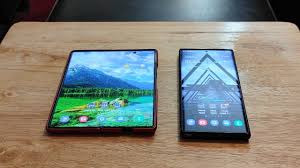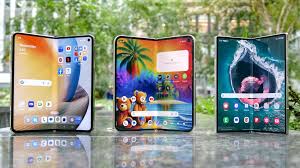Foldable phones 2025 have finally moved from concept and early adopters to a mainstream conversation: is the foldable phone market poised to grow into the future of mobility, or are foldables a high-profile fad destined to remain niche? This long-form guide examines the engineering (hinge, flexible OLED), market data, real-world durability, price and value, software adaptations, and whether foldables truly beat slab phones for everyday users.
1. Executive summary:
Foldable phones started as an expensive novelty but in 2025 they’re a credible category with better engineering, wider model ranges, and improving software support. Some of the world’s biggest manufacturers doubled down on foldables; Samsung’s Z Fold and Z Flip lines continue to set the tone while Chinese makers (Honor, Oppo, Xiaomi, Vivo) push innovation and alternative price points. Market trackers show the category has grown substantially since 2021 — although growth has been uneven and subject to short dips as supply and demand normalize. Notably, industry analysts forecast both short-term fluctuations and longer-term recovery as production scales and lower-cost clamshells (flip phones) hit broader audiences.
From a user perspective, foldables win in multitasking, media consumption and niche productivity tasks; but they still lag slab phones in price, repairability, and sometimes app optimization. Durability concerns that dominated early headlines have eased due to improved hinge engineering and IP improvements — yet perceptions persist. After reading this guide you should be able to decide whether a foldable fits your needs in 2025: whether you want the novelty and productivity boost of a larger screen, or the simpler, cheaper reliability of a slab phone.
2. A quick history of foldable phones:
Foldables trace their consumer roots to concept devices and prototypes presented between 2017–2019, but real commercial traction only began with Samsung’s Galaxy Fold (2019) and the later Z Flip and Z Fold iterations. Early models suffered fragile screens and hinge failures, and the category was widely criticized as premature. However, iterative hardware improvements — stronger flexible OLED panels, improved polymer coatings, and refined hinge designs — turned a headline problem into an engineering win. Meanwhile, clamshell foldables (flip-style) brought nostalgia plus practical cover screens that reduced the need to open the phone for quick tasks.
By 2023–2024 a wider array of brands entered the space, offering alternatives at various price points and form factors. That competition drove feature improvements (IP ratings, improved outer displays, larger inner screens) and gradually helped normalize consumer expectations — from “experimental” to “premium mainstream.” The result: foldables are now a recognized tier of modern smartphones, sitting between slab flagships and niche devices for creatives and power users.
3. Two form factors: Fold vs Flip (book vs clamshell):
Book-style foldables (Fold):

Book-style foldables (often called “Fold”) open like a small tablet — large inner displays (7″+), outer cover screens for standard phone tasks, and multi-window multitasking. The Fold line is ideal for productivity tasks: split-screen email and document editing, larger canvas for sketching, and better media viewing.
Clamshell foldables (Flip):
Clamshell foldables (Flip) fold into a compact package and emphasize pocketability. The inner screen is typically closer to a normal phone size, but the real draw is the compact folded form and increasingly capable outer displays for quick interactions, notifications, and even camera previews.
Which one is right depends on priorities: Folds for productivity and big-screen immersion, Flips for portability. Both 2025 trends show manufacturers offering both at varied price points, including lower-cost “FE” or budget flip models to reach broader buyers.
4. The technology behind foldables: hinges, displays, coatings:
Foldables marry mechanical engineering and advanced materials. At the core are:
- Flexible OLED panels: These use bendable substrates (polyimide or similar) instead of rigid glass. Advances have reduced visual creases and improved brightness/efficiency.
- Hinge engineering: Modern hinges incorporate multi-link mechanisms, anti-dust brushes, and proofed stress tests. Manufacturers have increased cycle ratings (200k+ folds) and improved structural rigidity. The hinge is the single most important durability improvement since 2019.
- Protective coatings & outer display glass: Ultra-thin glass (UTG) options and polymer overlays reduce scuffing and improve tactile feel. Some makers supply replaceable outer screen protectors.
- IP and durability seals: For years foldables lacked water/dust ratings; now some models achieve IP ratings (water/dust resistance), thanks to better sealing and hinge covers. The Pixel 10 Pro Fold and recent Samsung models showcased notable advances in this field.
These engineering gains make modern foldables more reliable. Still, flexible panel repair is currently more complex and expensive than slab glass replacements, and UTG is thinner — tradeoffs remain.
5. Durability: myths vs reality:
Durability dominated early skepticism. Viral tests in the category’s infancy showed phones failing under folding cycles and pocket lint infiltration. But real life isn’t stress testing — and engineers responded.
What’s changed:
- Manufacturers now publish fold cycle ratings (often in the hundreds of thousands) and run accelerated lifetime testing in factories.
- Hinge design improvements include bristles and seals to prevent ingress; improved materials and lubrication reduce wear.
- Screen materials improved from early plastic to UTG (Ultra Thin Glass) and better polymer stacks — improving scratch resistance and feel.
Current reality: Many modern foldables handle daily use reliably. Independent durability tests and user reports note far fewer hinge and screen failures than early models, and some brands even post improved sales despite increased competition. However, foldables still require more cautious handling (no pressure on the closed screen, protection against sharp objects), and repairs (outer or inner panel replacement) remain costly compared to slab phones. The cost of accidental damage coverage or insurance should be factored into ownership cost.
6. The foldable phone market in numbers (shipments, growth & forecasts) — data & analysis:
Understanding whether foldables are a fad depends on the data:
- Market trackers reported strong growth in early years, a stall in 2024 and a dip in 2025 projections as the category normalized after explosive expansion. Counterpoint Research noted a potential decline in 2025 before a projected comeback in 2026, highlighting short-term volatility as supply/demand rebalances.
- Industry panel trackers and display companies reported that foldable panel procurement slowed in 2024 and was forecast to fall in 2025, indicating a temporary lull as manufacturers recalibrated inventories and consumer demand adjusted. DSCC (Display Supply Chain Consultants) signaled a contraction in foldable panel demand, with procurement stalling around 22 million panels and a decline forecast in 2025.
- Conversely, Q2 2025 trackers from Counterpoint and IDC reported pockets of recovery, with YoY foldable shipment increases in certain quarters and growth returning in 2025 Q2 thanks to North American recovery and new price-competitive models. IDC forecasts also point to accelerating foldable adoption beyond 2025 as unit costs fall and more affordable models appear.
Key takeaways from the numbers:
- Foldables are no longer a tiny experimental niche — they form a recognized, growing premium segment that fluctuates with prices and model availability.
- Growth in 2025 is uneven: some months/regions show rebound (North America, parts of Europe), while other regions slow while awaiting lower-cost models.
- Analysts expect the category to mature: initial rapid percentage growth gives way to steadier adoption as the product moves from early adopters to mainstream buyers.
In short, the foldable phone market shows the characteristics of an emerging product category undergoing maturation rather than a pure fad that will disappear.
7. Why consumers buy foldables — real use cases:
People buy foldables for practical and emotional reasons:
- Productivity & multitasking: A Fold can run multiple apps side-by-side — email plus document editing plus video call — much closer to a tablet experience than a slab phone.
- Media & gaming: Larger inner screens provide immersive video and gaming experiences without needing a tablet.
- Novelty & status: For many consumers, owning the latest foldable signals tech enthusiasm or status — similar to early adopters of other premium gadgets.
- Photographers & content creators: Foldables often provide unique camera interfaces: preview on a larger inner screen, improved stabilization options, and new shooting angles.
- Portability without compromise: Flips pack a larger screen experience into a compact folded footprint — for people who want a big screen but also pocketability.
These use cases translate to tangible benefits: faster multitasking, fewer device switches (phone to tablet), and improved media consumption.
8. Weaknesses: cost, weight, app optimization, repairability:
Foldables are compelling, but not without tradeoffs:
- Price: Foldables are typically premium devices; although prices have come down, they still sit above most slab flagships. Manufacturers have addressed this with Fan Edition (FE) flips and more affordable clamshells, but cost is a factor for widespread adoption.
- Weight & thickness: Foldables are generally heavier and thicker, especially book-style models. This can deter users who prefer light, thin phones.
- App optimization: While Android has improved foldable support, not all third-party apps correctly adapt to large inner displays. The experience has improved since 2021-22, but inconsistencies remain.
- Repairability & insurance costs: Inner screen repairs are complex and expensive compared to replacing a slab glass. Many users opt for device protection plans to offset repair risk.
- Battery life & heat: Larger screens and multitasking demands can strain battery life; foldables often use split battery architectures which can complicate thermal management.
These weaknesses are real but improving: software optimization continues to evolve, and component costs tend to fall with volume — so many of these pain points soften over time.
9. Manufacturers & flagship foldable models to watch in 2025:
Several key players push the tech forward:
- Samsung: Still the category leader with the Galaxy Z Fold and Z Flip series; Unpacked 2025 announced Z Fold7 and Flip7 with slimmer bezels, bigger cover displays, and midrange “FE” flip models that target broader audiences. Samsung’s scale drives supply chain improvements and price pressure.
- Google: Pixel fold models have emphasized software integration and water/dust resistance (IP ratings), which address two major consumer concerns. Google’s approach focuses on user experience and timely OS updates.
- Honor, Xiaomi, Oppo, Vivo: These Chinese manufacturers often lead in display innovation and competitive pricing. Honor’s Magic V5 (for example) pushed thinner panels and big battery implementations, attracting customers seeking alternatives.
- Motorola: The Razr line targets more affordable flip experiences and introduced accessible price points to bring flips to new customers.
Why this matters: Competition reduces price, drives faster feature improvements, and expands geographic availability — all factors that convert foldables from niche to mass market.
10. Foldables vs slab phones — when to choose which:
Choose a foldable if:

- You value a larger screen for productivity or media without carrying a separate tablet.
- You like to multitask on the go (split windows, drag-and-drop).
- You enjoy new form factors and are willing to pay a premium for innovation.
Choose a slab phone if:
- You want a lighter, cheaper device with predictable durability and easier repairs.
- You need the most reliable camera experience at the lowest weight and cost.
- You prefer the broadest accessory and case ecosystem.
Both categories will coexist: foldables for power users and enthusiasts; slabs for the mass market and value buyers.
11. Future roadmap: cheaper materials, wider adoption, and 2-in-1 convergence:
Looking forward, foldable phones will likely follow the typical adoption curve for successful consumer electronics:
- Economies of scale and alternative materials will lower component costs. Panel makers and hinge suppliers ramp production to support wider rollout.
- Software ecosystems will improve — Android and app developers increasingly optimize for large inner screens and multi-window workflows.
- Form factor evolution: Expect thinner folds, rollable concepts, and hybrid designs — but rollables face their own challenges (mechanical complexity, sealing, and cost).
- Accessibility & price: As manufacturers introduce lower-cost flips and mainstream fold models, adoption will spread beyond early adopters into broader consumer segments.
- Integration with other devices: Foldables may act as a hub for mobile computing — docking to monitors, pairing with Bluetooth keyboards, or serving as primary productivity devices for some users.
Analysts predict an uneven but upward trajectory: after short dips and corrections, foldables can scale significantly by the late 2020s as prices decline and consumer use cases solidify.
12. Buying guide: what to look for in a foldable in 2025:
When shopping:
- Durability ratings & hinge reviews: Look for independent cycle tests and IP ratings.
- Inner display type & crease visibility: UTG panels look and feel better than pure plastic.
- Outer cover screen usefulness: A snappy, large cover screen reduces the need to unfold.
- Battery capacity & charging: Foldables consume more power; check real-world battery tests.
- Repair policy & price of spare parts: Factor repair cost into total ownership.
- Software support & updates: Longer OS and security update promises increase device longevity.
- Price vs value: Decide if productivity and novelty justify the premium. Look for FE/budget flip options if you want value.
Try to test the device in a store to feel hinge action, check for creases, and test multitasking features.
13. Environmental & sustainability concerns:
Foldables use more complex components and assembly — which can increase environmental impact per unit. On the flip side, a foldable that replaces phone + tablet might reduce total device footprint for some users. To be responsible:
- Choose devices with long software support (fewer replacements).
- Repairability matters — modular designs and accessible spare parts help.
- Manufacturers should commit to recycling programs and transparent sourcing.
Sustainability will be an area of scrutiny as foldables scale — and better design for repairability and longer update windows will be key selling points.
14. Final verdict — fad or the future?:
Foldable phones are not just a fleeting fad. The category shows the hallmarks of lasting product innovation: iterative engineering fixes to early failures, broadening product lines across price points, and meaningful consumer use cases (productivity, media, pocketable large screens). Market data shows uneven growth, with short declines followed by rebounds as manufacturers expand offerings and reduce prices — that’s maturity, not collapse.
Will foldables replace slab phones entirely? Unlikely in the near term. Instead, foldables will coexist as a premium and increasingly mainstream tier, much like tablets did after smartphones matured. If you prize multitasking and screen real estate — or want to be on the cutting edge — a foldable in 2025 is a legitimate purchase. For most buyers who prioritize simplicity, price and durability, slab phones remain the sensible choice.
15. External references & further reading:
- Counterpoint Research — Global foldable smartphone market tracker and analysis. Counterpoint ResearchCounterpoint Research
- DSCC — display & foldable panel procurement trends. Display Supply Chain Consultants
- The Verge — foldables buyer guides and reviews. The Verge+1
- IDC — worldwide smartphone market forecasts and foldable outlook. My IDC+1
- Samsung Unpacked 2025 coverage — product launches and strategy. The Verge
16. Internal Links:
- Biometric Security: Safer or Riskier? — Understanding Biometric Authentication, Risks & Privacy
- How Artificial Intelligence is Changing Computing: Innovations, Impacts & The Future
- Evolution of Computers: From Vacuum Tubes to Quantum Machines
- Top 10 Mobile Accessories That Actually Improve Your Experience (2025 Guide)




Leave a Reply